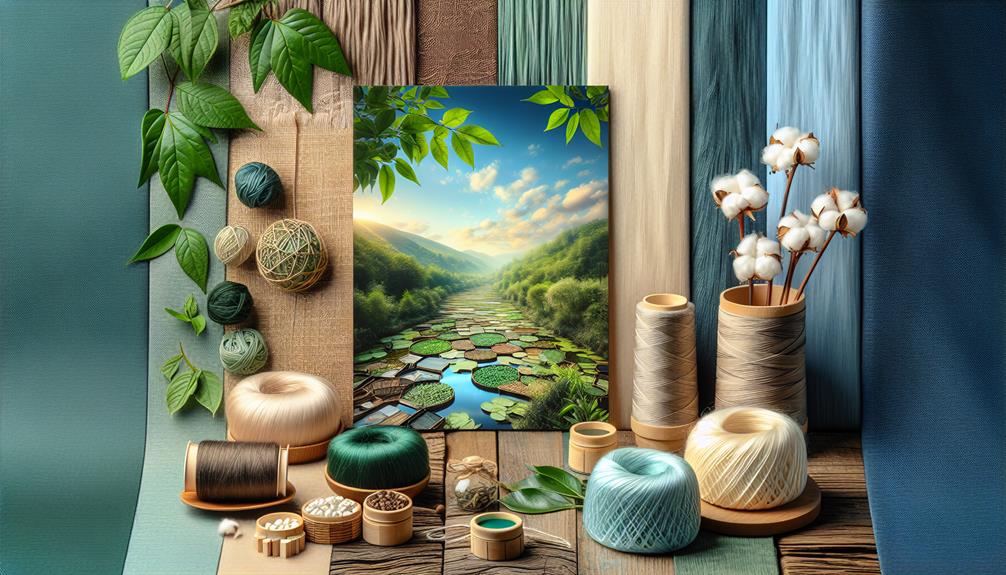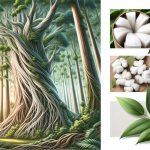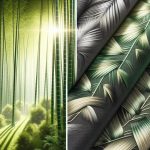I've always appreciated silk for its softness and luxury, but I've found that Tencel Lyocell is surprisingly similar. Tencel, made from eucalyptus wood pulp, matches silk in smoothness and comfort, yet it's more sustainable and ethically produced. Both fabrics are breathable, moisture-wicking, and offer a luxurious feel against the skin. However, Tencel is more durable and easier to care for than silk. It's also hypoallergenic and friendly to sensitive skin. While they share many qualities, choosing between them might depend on your values, especially regarding environmental impact and ethical concerns. There's a lot more to uncover about their unique advantages.
Table of Contents
Key Takeaways
- Tencel Lyocell offers a softness and smooth texture similar to silk, enhancing comfort and luxury.
- Both Tencel and silk are breathable and excel in moisture-wicking, suitable for various climates.
- Tencel is a more sustainable and cruelty-free alternative, avoiding the ethical issues associated with traditional silk production.
- Unlike silk, Tencel is more durable and easier to care for, resisting frequent water exposure better.
- Tencel and silk both regulate body temperature effectively, though Tencel has a slight edge in moisture management.
Understanding Silk
Silk's luxurious feel and shiny appearance come from silkworms, which produce this natural fiber. Harvesting silk is an ancient art, involving a delicate production process where silkworm cocoons are boiled to extract the fibers. This method, while traditional, does raise ethical concerns due to the treatment of the silkworms.
As a natural material, silk stands out for its breathability and moisture-wicking properties, making it a top choice for comfort in both clothing and luxury bedding. Its inherent softness and ability to regulate temperature enhance its appeal, ensuring that whether I'm dressing up for an event or settling down for a good night's sleep, silk provides unmatched elegance and comfort.
Despite its benefits, the ethical implications of traditional silk production have led some to seek alternatives like TENCEL™, which aims to offer similar qualities without the same moral dilemmas. However, for those who value natural fibers and are conscious of their choices, the allure of silk, with its centuries-old heritage of strength and luxury, remains undeniable. It's a testament to human ingenuity in fabric making, balancing luxury with functionality.
Exploring Tencel Lyocell
Let's dive into Tencel Lyocell, a sustainable fabric that's gaining popularity as an ethical alternative to silk. Originating from wood pulp, mainly eucalyptus, Tencel Lyocell stands out as an eco-friendly choice. Its production employs a closed-loop system where nearly all chemicals are recycled, significantly reducing environmental harm.
This fabric isn't just about being good for the planet; it also offers a luxurious softness that rivals silk, making it a favorite for both fashion and home textiles. The breathability of Tencel Lyocell ensures it feels light and airy against the skin, which adds to its appeal.
I've found its moisture-wicking properties particularly impressive. This feature promotes cleanliness and comfort, making Tencel Lyocell ideal for those with sensitive skin or anyone who prioritizes hygiene. Plus, it's more cost-effective than silk, which means you can enjoy this cruelty-free luxury without breaking the bank.
Choosing Tencel Lyocell means supporting an environmentally conscious option that doesn't sacrifice quality or comfort. Whether it's the ethical production process or the user benefits, it's clear why Tencel Lyocell is a top contender for those seeking sustainable yet luxurious textile alternatives.
Properties of Silk
While Tencel Lyocell offers a modern, eco-friendly alternative, silk holds its own with a long-standing reputation for luxury and durability. As a natural fiber, silk's luxurious feel and lustrous sheen are hard to replicate. Produced by silkworms, this fabric has graced societies for centuries, not just as clothing but also as a valuable commodity.
The strength and durability of silk are notable. Despite its delicate appearance, it stands up to wear and tear quite well, making it a favorite in the world of textiles. The production process of silk is fascinating; it involves carefully unraveling the cocoons spun by silkworms to extract fine, smooth threads. This meticulous process contributes to the fabric's unique qualities.
Moreover, silk is hypoallergenic, making it a great choice for sensitive skin. Its natural temperature-regulating properties also mean that it's comfortable in both warm and cool climates, adapting to your body's needs. This combination of beauty, practicality, and comfort is what keeps silk in such high esteem. Whether you're dealing with summer heat or winter chills, wearing silk can help you maintain the perfect balance of comfort and elegance.
Benefits of Tencel
Tencel offers impressive benefits as a sustainable fabric, combining luxury with environmental responsibility. Derived from wood pulp, this material not only mirrors the strengths and longevity of silk but also touts a silky smooth texture that's a real treat for the skin. It's luxurious, sure, but what's even better is how it aligns with eco-friendly values.
I find Tencel's hypoallergenic properties particularly appealing. It's a blessing for those, like me, with sensitive skin. This fabric doesn't irritate, and its softness is comparable to that of silk, ensuring comfort doesn't come at the expense of performance. Speaking of performance, Tencel's moisture-wicking ability is another standout feature. It effectively draws moisture away, keeping you cool and dry, which is ideal for bedding and activewear.
What seals the deal for me is Tencel's commitment to sustainability. It's not only biodegradable but also recyclable, making it a poster child for sustainable fashion. In a world where eco-conscious choices are increasingly vital, Tencel stands out as a responsible and luxurious alternative to traditional fabrics. It's a win-win in my book – comfort paired with care for our planet.
Challenges With Silk
While silk is often praised for its luxurious feel, it's not without its problems.
I'm concerned about the ethics of silk production, as it involves harming millions of silkworms.
Beyond that, silk isn't the easiest to care for and it can have durability issues, making it less practical for everyday use.
Silk Production Ethics
Silk production raises serious ethical concerns because it involves boiling silkworms alive to extract their fibers. Each year, this practice results in the death of billions of these creatures, clashing with vegan and cruelty-free principles.
Thankfully, peace silk presents an alternative method, adhering to harm reduction by allowing silkworms to live out their natural lifecycle before the silk is harvested. This approach aligns more closely with cruelty-free principles, offering a more ethical option.
Moreover, the quest for sustainable alternatives has spotlighted materials like Tencel Lyocell, which doesn't rely on animal products and offers a viable, ethical substitute. These developments are crucial for those of us seeking to make responsible, compassionate choices in our fashion consumption.
Care Requirements
Maintaining the beauty of silk garments often requires dry cleaning, adding to their overall cost and care complexity. Silk's delicate care isn't just about keeping it clean; it's also about battling shrinkage. If you're not careful, a beautiful silk blouse can end up a size smaller after a wash. Plus, there's the annoying issue of static electricity. Ever noticed how silk attracts every speck of dust or lint around? That's static for you, making silk a demanding care magnet.
Considering Tencel Lyocell, though, it's a different story. It offers durability without the high price point and challenging fabric issues that make silk so tricky to handle. The care requirements for Tencel Lyocell are less stringent, giving it a practical edge over silk.
Durability Concerns
Tencel Lyocell outshines silk in durability, especially when it comes to handling moisture. While silk's allure is undeniable, it lacks the resilience needed for frequent water exposure. Silk demands special care during washing and handling, or else it's prone to damage. This makes maintenance a bit of a hassle.
On the other hand, Tencel Lyocell thrives with regular use, maintaining its strength and shape far better than silk. Its durability makes it a more reliable choice for those who value longevity in their garments. If you're after a fabric that can withstand the wear and tear of daily life without constant worry, Tencel Lyocell is definitely the way to go.
Drawbacks of Tencel
While Tencel has its perks, it's not without its downsides.
For starters, it's not as durable as you might hope, which can be a deal-breaker for some.
Also, it's pretty sensitive to moisture, so you've got to be careful when you're washing it or wearing it on damp days.
Limited Durability Concerns
Although Tencel feels luxurious and soft, its durability mightn't match up to silk, as it tends to pill and wear out quicker in areas of high friction. I've noticed that despite its comfort, Tencel mightn't always hold up well under stress, especially where there's a lot of rubbing or movement.
This limited durability can lead to pilling, where small balls of fiber form on the surface, and even tearing after frequent use. It's a bit disappointing because you'd expect the strength to match its softness. The eco-friendly production process of Tencel, while great for the environment, seems to compromise its longevity a bit.
Moisture Sensitivity Issues
Beyond its durability concerns, another issue I've noticed with Tencel is its sensitivity to moisture. When exposed to high humidity, Tencel tends to wrinkle, which can be a real hassle. It absorbs moisture too, making the fabric feel damp or heavier than usual, which really drops the comfort levels. You've got to follow specific care instructions to keep it looking good and performing well, which means extra work.
In humid climates, this moisture sensitivity can mess with the fabric's performance, making it less ideal. Understanding these drawbacks is crucial for deciding if Tencel's right for your needs, especially if you live in a place with a lot of dampness or high humidity.
Comparing Textures
Tencel Lyocell feels incredibly smooth and silky, much like traditional silk. When I first touched a piece of Tencel Lyocell fabric, I was struck by its luxurious feel. It's not just soft; it offers an elegant feel that rivals the finest silk. This similarity in texture makes Tencel a fantastic choice for anyone who loves the tactile experience of silk but might be seeking an alternative.
Both Tencel Lyocell and silk provide a similar comfort that's hard to find in other fabrics. They're both incredibly gentle to the touch, which is a huge plus for those with sensitive skin or allergies. You know how some materials can irritate your skin or cause discomfort? Well, that's rarely an issue with either of these fabrics. Their smooth texture ensures that they glide over your skin without any abrasiveness.
Having used both materials in various clothing, I can attest to their comparable luxuriousness. Whether it's a blouse, scarf, or even bedding, choosing between Tencel Lyocell and silk often comes down to personal preference rather than a compromise on quality or comfort. Both materials envelop you in an undeniable softness that enhances every wear.
Moisture Management
When it comes to moisture management, Tencel Lyocell really stands out with its enhanced absorption qualities. It's not just about staying dry; this fabric also dries quickly, which is a huge plus.
Let's see how these features stack up against silk, especially for those of us who tend to get a bit sweaty at night.
Enhanced Absorption Qualities
Like silk, Tencel Lyocell excels in managing moisture, keeping you dry and comfy throughout the night. Its strong moisture absorption properties ensure that even hot sleepers or those who sweat a lot won't feel clammy. This is because Tencel Lyocell's moisture-wicking properties are top-notch, pulling sweat away from your body swiftly.
What's more, this ability to manage moisture contributes significantly to regulating your body temperature. So, you're not just dry; you're also at the right temperature, which makes for a more restful sleep. Plus, all this moisture management helps to maintain a fresh sleeping environment.
It's this blend of practical benefits with a luxurious feel that makes Tencel Lyocell a standout fabric.
Quick Drying Capabilities
Building on its ability to manage moisture, Tencel Lyocell also dries quickly, ensuring that comfort is maintained throughout the night. This quick-drying feature is crucial for those like me who tend to sweat while sleeping. It keeps the bedding fresh and reduces the chance of waking up feeling damp.
Just like silk, Tencel Lyocell's moisture-wicking properties play a big role here. It efficiently pulls moisture away from the skin, allowing a breathable and cool sleeping environment. This means I can enjoy a dry, comfortable sleep without worrying about odors or discomfort from humidity.
The moisture management of Tencel Lyocell not only matches silk but also enhances the overall sleep experience by keeping things fresh and comfortable.
Eco-Friendly Aspects
Tencel Lyocell stands out as a more eco-friendly option than silk, thanks to its sustainable and cruelty-free production process. Derived from renewable wood pulp, primarily eucalyptus, it's a poster child for sustainable fashion. Unlike the traditional silk production, which often involves the killing of silkworms, Tencel Lyocell is 100% plant-based and cruelty-free. This factor alone makes it a favorite among ethical consumers.
Moreover, its manufacturing process features a closed-loop system. This means almost all water and solvents used are recycled and reused, minimizing waste and environmental pollution. It's a stark contrast to silk production, which typically requires more water and involves processes that are not as kind to our planet.
Tencel Lyocell is not only eco-friendly during production but also at the end of its life cycle. It is both biodegradable and compostable, ensuring that it returns to the earth without leaving harmful residues. Here's a quick look at how Tencel Lyocell compares to silk:
| Aspect | Tencel Lyocell | Silk |
|---|---|---|
| Source | Sustainable wood pulp | Animal-based |
| Production Process | Closed-loop, water recycling | More water-intensive |
| End of Life | Biodegradable, compostable | Less eco-friendly |
This table highlights why I'm leaning towards Tencel Lyocell for eco-conscious fabric choices.
Luxury Vs. Affordability
While we've explored how Tencel Lyocell is more eco-friendly than silk, it's also worth noting its luxurious feel at a more affordable price. Tencel Lyocell really hits the mark when you're looking for that high-end feel and appearance without draining your wallet. It's got all the hallmarks of luxury—smoothness, sheen, and a drape that rivals silk. But here's the kicker: it's far more budget-friendly.
This fabric isn't just about looking good; it's about feeling good without compromise. Whether you're decking out your bedroom or upgrading your wardrobe, Tencel Lyocell offers a balance of quality and affordability that's hard to beat. It's a practical alternative for anyone who loves the opulence of silk but not its price tag. You get the same touch of elegance and comfort, which makes it a popular choice among those who are mindful of their spending.
In essence, if you're aiming for a luxurious vibe but your budget is tight, Tencel Lyocell is your go-to. It maintains that plush, high-quality feel while keeping things real with your bank account. It's a win-win for both luxury seekers and savvy shoppers alike.
Choosing Your Fabric
When choosing between Tencel Lyocell and silk, it's crucial to consider both your lifestyle needs and ethical values. If you're leaning towards options that align with eco-friendly practices and sustainability, here's a little breakdown to help you decide:
- Eco-Friendly and Sustainable Choices:
- Tencel Lyocell is celebrated for its environmentally conscious production process, making it a top pick if you prioritize planet health. It's a clear winner over silk, which has a heavier environmental and ethical toll due to traditional sericulture practices.
- Performance and Comfort:
- Both fabrics offer a luxurious feel and smooth texture, but Tencel Lyocell steps up with its moisture-wicking capabilities and superior temperature regulation. This makes it ideal for a range of climates and extensive wear.
- Cost-Effectiveness and Ethical Considerations:
- Opting for Tencel Lyocell can also be more cost-effective without sacrificing quality. Plus, it's cruelty-free, sparing the lives of silkworms, which is a significant ethical advantage over silk.
Choosing the right fabric involves a mix of personal preference and values. Whether it's the soft allure of silk or the sustainable, cruelty-free comfort of Tencel Lyocell, your choice reflects more than just taste—it's about the impact you want to make.
Frequently Asked Questions
Is Tencel Lyocell Silk?
Tencel Lyocell isn't silk, but it's a great alternative. It's eco-friendly, derived from wood pulp, and offers a similar feel. Unlike silk, it's cruelty-free and has a more sustainable production process.
Does Lyocell Feel Silky?
Yes, I've found that Lyocell does feel silky. It's got a smooth, luxurious texture that's very comfortable against the skin and drapes beautifully, much like silk.
What Is Tencel Lyocell Similar To?
Tencel Lyocell is similar to silk because it's soft, smooth, and has a luxurious feel. It's also moisture-wicking and offers a subtle sheen, making it great for high-quality garments and bedding.
Is Tencel as Good as Silk for Hair?
Yes, I've found Tencel to be as good as silk for hair. Its smooth fibers reduce friction, prevent tangling, and keep hair hydrated, making it a fantastic alternative without ethical concerns.
- How Does Ring Spun Cotton Affect Garment Fit and Shape Retention? - August 13, 2024
- What Are the Challenges in Producing Ring Spun Cotton? - August 13, 2024
- Is Ring Spun Cotton Suitable for Plus-Size Clothing? - August 13, 2024







